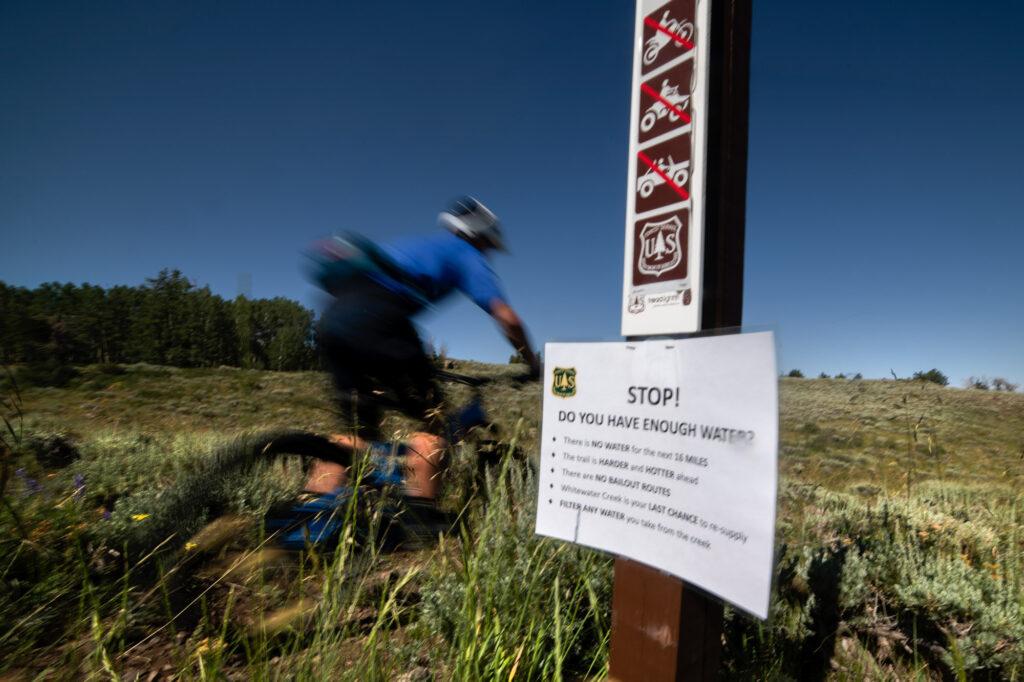
The Grand Mesa looms like a huge ship in the distance over much of Mesa County. At about 11,000 feet of elevation, it offers an alpine respite from the often scorching valley below. And for decades, mountain bikers asked themselves the same thing: What if I could ride down it?
Now they can.
The opening of the Palisade Plunge trail was a huge street party in the little town of Palisade last summer, with appearances by Gov. Jared Polis and U.S. Secretary of the Interior Deb Haaland. Countless magazine articles were written about the trail, and there was talk — probably more than ever — about Mesa County becoming a worldwide mountain biking destination.
But a year later, there are also calls for caution, following the heart-related death of a rider on the Plunge. Even the trail’s biggest supporters are looking at how the 32-mile odyssey can be improved.
The start of the Palisade Plunge, however, doesn’t show many signs of the danger that lies ahead. It’s a high-elevation, delectable appetizer, singletrack and pretty flat, winding past pine trees and bright-green meadows dotted with wildflowers, bursts of red and orange.
But all that changes quickly.
Cameron Brenneman, from nearby Grand Junction, has ridden the trail several times with friends. He’s never personally had a problem, but almost everyone with him has run out of water.
“I think people just aren't ready for how hot it is,” he said, taking a break from a different trail on the mesa on a recent morning.
While it was about 70 degrees right then, it would be more than 100 in Palisade, the trail’s end, that afternoon. It’s the kind of wild swing that makes it easy to kid yourself, not realizing it will only get hotter the farther you ride.
A few days before, Brenneman’s girlfriend ran across a group from Denver starting out from the top with only two small water bottles. She offered them more water, but they refused.

“They said they were okay ‘cause they're used to riding in the desert,” Brenneman said, with a knowing laugh. “And then I saw their post when they finished. They said they're tired, exhausted, outta water.”
And while it’s called the Plunge, don’t be fooled by the name. Palisade resident Chip Wernig explained it is not all downhill.
“Not at all,” he said, sounding out each word with a serious tone. “Not at all.”
Though the trail descends about 6,000 feet, it also climbs about 1,700. It has the kind of views of the valley floor that make you instinctively open your mouth in amazement. But there are also perilous drop-offs. So Wernig and wife, Catherine Roberts, decided to do a different trail that day. For them, one trip down the Plunge a year is enough. Wernig described it as “really fun,” while his wife added that you have to “plan for it.”
“And be up for it physically,” Wernig said.
But that can be incredibly hard to gauge. This June, during the summer’s first big heat wave, an experienced rider from Colorado Springs ran out of water and overheated. The 52-year-old man died on the trail, only 4 miles from the end. And his death has sparked an urgent conversation about how to manage the Plunge.
Down in the little town of Palisade, Rondo Buecheler runs Palisade Plunge Shuttle Services. He explained that he looks carefully at each person he plans to drop off at the trailhead.
If they don’t have the “right bike, the right attire, the right amount of water, the right attitude,” he’ll tell them not to do it, he said, “and gladly refund their money.”
Buechler, one of the many people who worked for years to create this trail, has given several of those refunds. On really hot days, he often won’t even run a shuttle.

“It’s a very remote ride, even though you're looking over the Grand Valley the whole time, you're in the middle of nowhere,” he said. “You can't get there easily.”
There are few routes to leave the trail, often called “bailouts,” if you’re in trouble. There’s also only one spot with water — a creek, which requires a water filter.
Colorado Mesa University’s Nate Bachman explained that the Plunge can be especially dangerous for riders visiting from cooler places, with lower elevation.
“Something to consider is about seven to 14 days is when our body can fully adjust to the heat,” he said.
So coming in for the weekend just to do the Plunge might not be a great idea. In addition to being an instructor at CMU, he’s the assistant director of the Monfort Family Human Performance Lab, which studies these kinds of questions.
There are no hard-and-fast rules about how hot is too hot to attempt something like this, but in the arid environment of western Colorado, “when air temperature is above 80 degrees, we need to be careful, bottom line,” he said.
For Bachman, that means with any outdoor exercise in the area, it’s good to get out early, go with a buddy, and get a few good gulps of water or a sports drink every 10 to 15 minutes. It means carrying more food and liquid than you think you need.
Increasingly, for those who promote the Plunge, it also means encouraging people not to start at the top, but about 17 miles into the ride, a gorgeous spot with easy access called Shirttail Point.
That’s where the Bureau of Land Management's Greg Wolfgang peddled through a few mornings later, as butterflies flapped across the narrow trail, and a chipmunk scurried into the grass. He’s always awed by the view of the verdant valley, thousands of feet below.

“Seeing all that agriculture and farming and town and looking across at Mount Garfield, it's just a wonderful experience” said Wolfgang, a field manager at the BLM’s Grand Junction office.
He was standing at the dividing line between intermediate and advanced terrain. Soon, the trail becomes tight switchbacks with little room for error. Later, it cuts through rough desert, with no shade. From here on out, the Plunge gets tough.
“You know, it's our responsibility to put that information out and we're working really closely with our partners to do that,” Wolfgang said.
Those partners include the bursting roster of agencies and groups that helped make the Plunge possible: the Colorado Plateau Mountain Bike Trail Association, the U.S. Forest Service, Colorado Parks and Wildlife and many others. Local bike shops are helping prepare riders for the trail, as well. A few kiosks on the mesa describe the challenge. but they don’t say much about water, though temporary signs have been added.
Wolfgang said that permanent signage about hydration and heat is coming. However people get the message, he wants them to understand that this is an “awesome, spectacular trail,” he said, “but it's also very technical and committing. And you need to be prepared when you come here.”
Ultimately, he went on, each person is responsible for their own safety, the same as on all public lands.
More tweaks are in the works for the Plunge, maybe additional bailouts and better marking for the sole water source. But one thing that no one mentioned was closing the Plunge on hot days. That’s not really how public land works, I was told.
Still, the trail’s difficulty can even surprise locals, including Garrett Rodstrom, who grew up in the area. He knows these kinds of challenges well, as the vice president of the Mesa County Search and Rescue Ground team.

The Plunge is “kind of a mad science experiment of, you know, all of the things that make mountain biking extreme,” he said, standing at the end of the trail in Palisade, under the merciful shade of tall trees.
He thinks that better information about the trail could have been shared in the beginning but that all the trail’s partners seem to be taking the right steps now. Plus, there have been only a handful of rescues each season here.
Despite the dangers, Rodstrom enjoys the ride.
“I mean, it’s just a hoot,” he said. “It’s a lot of fun, but yeah, there’s some definite risk there.”
I decided to stick around late into the afternoon, looking to talk to someone who just got off the trail, having left later than they should. I came the next few days, too, camping out in the baking heat with water and a recorder. But I didn’t find anyone.
So maybe this safety message for the Palisade Plunge is getting across.








